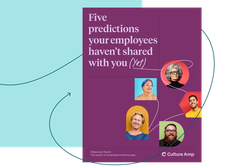
Written by

The employee experience platform
What will working habits look like in the year 2030? There’ll be plenty of changes, no doubt – and we’re not talking about robot bosses. The biggest shifts are more fundamental than that. In fact, we don’t even need to fast-forward to reach them. They’ve already begun.
The COVID-19 pandemic showed employees what flexibility at work looks like. Now, employees across generations recognize the benefits of working in hybrid and remote environments. Today’s employees know what they want from employers, and flexibility ranks high on the list.
Meeting new employee expectations for flexibility
Prior to the COVID-19 pandemic, Culture Amp data shows that just 5% of companies worked remotely. In Britain, for example, 68% of employees had never worked from home.
In September 2020, Culture Amp surveyed 349 customers on their organizational response to COVID-19. 58% of participants reported that they had started providing their employees with funds or resources to set up a home workplace.
The pandemic called the old rules into question, and working in the office full-time is no longer a widely accepted norm. Employee expectations of hybrid and remote working have evolved, but many employers haven’t caught up. A year after the pandemic started, 64% of respondents in a global McKinsey survey said they’d like to work from home one to four days a week. Yet 68% said they hadn’t received any detailed vision of what that might look like.
Employees have made their expectations clear, but for employers, flexibility at work is more complex. As companies create policies and practices to support hybrid or remote workers, they strive to balance their company culture and values with employee expectations of flexibility at work. Getting it wrong damages the employee experience (EX), and a poor EX can have negative repercussions for the whole company.
Flexibility at work means different things to different people. The way forward is to explore what flexibility means to your employees and determine how to address those expectations across the workforce.
Flexibility at work has different benefits for different demographics
In a 2021 Jabra survey of 5000 workers across France, Japan, the U.K., and the U.S., 59% ranked flexibility higher than salary or other benefits. But for employers, recognizing the value employees place on flexibility at work is only a first step. It’s just as important to understand why your employees find hybrid and remote work appealing.
Exploring who makes up your workforce – and what matters to them – will help you make better decisions. Demographic preferences are a useful starting point.
Baby boomers (born 1946 - 1964) and Generation X (born 1965 - 1980)
Baby boomers tend to prioritize family time, especially because of their grandchildren and elderly parents. Offering remote work can be especially valuable to this cohort, who may view it as a chance to delay their retirement. Recent LinkedIn data suggests that baby boomers are also 15% more likely to apply for remote work. Gen X employees are similarly inclined to be “pro-remote,” and happier to meet with members of their team less regularly in person.
Millennials (born 1980 - 1997)
Millennials value hybrid working more than their older colleagues. Research from Deloitte suggests twice as many under-35s want permanent flexible working compared to over-55s. Even before the pandemic, Pentagra found that over 50% of HR teams had noticed a rise in millennial candidates asking about flexible working benefits during the hiring process. Allowing for hybrid work schedules can play a key role in retaining the generation most likely to switch jobs.
Gen Z (born 1997 - 2012)
The youngest generation of workers views hybrid working as non-negotiable. Microsoft’s World Index 2022 reveals that 58% of them were considering a shift to hybrid work. At the same time, they’re more likely to miss interacting with coworkers in person compared to millennials.
Using organizational justice to build consensus
How can your company ensure that its workplace flexibility policies align with employees’ needs? When fleshing out flexible work strategies, research shows the two most important factors to consider are the process and how employees are treated.
Organizational justice, a concept introduced by Dr. Jerald Greenberg in the 1980s, can help you understand what drives employee perceptions of fairness and value and how these perceptions shape the employee experience at your company. Organizational justice focuses on three factors:
Process
- Were decision-making rules clear and consistent?
- Were potential biases acknowledged and minimized?
- Did I have an opportunity to voice my input?
Interactions
- Was I treated with respect and compassion?
- Was I informed on how the process works?
Outcomes
- Did I get what I wanted?
- Was it appropriate and equitable?
Thinking beyond flexible working
When employers think about flexibility at work, they’re focused on the work aspect – employee engagement and employee experience. But from an employee’s perspective, the emphasis is on flexibility and how it affects their lives in and out of work.
Delivering a one-size-fits-most policy for flexible working might deliver quick wins in the short term. But on a longer timeline, it’s worth optimizing the employee experience on an individual basis. Millennial and Gen Z workers are likely to value time off to prioritize their mental health, while over-55s may appreciate office hour slots dedicated to wellbeing.
As your company adapts to the changing needs of the workforce, collecting feedback will shed light on what individual employees value and set the foundation for a longer-term strategy. Employees across generations have come to expect flexibility at work, and employers who meet this expectation are setting themselves up for success – now and in the future.






